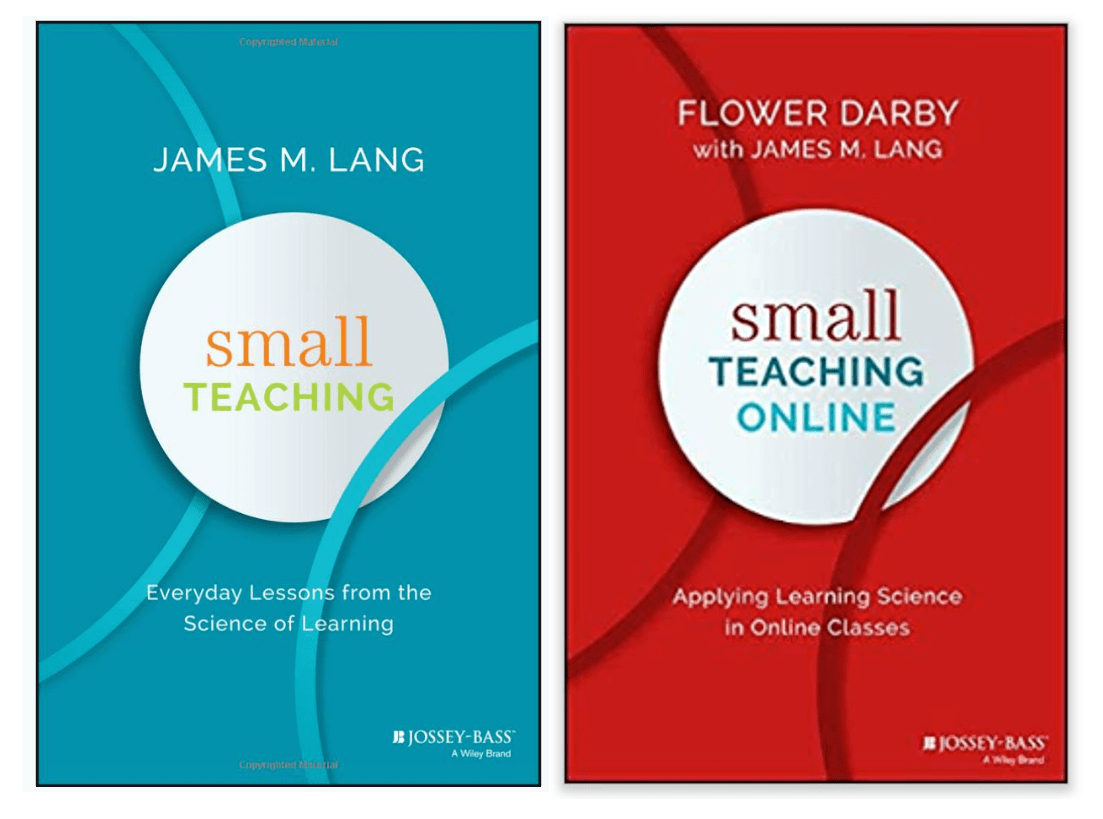 A little over four months ago, I posted about Jim Lang’s book Small Teaching: Everyday lessons from the science of learning (2016). In this book, Jim suggested a number of small modifications to teaching that could spark positive change, usually in the form of brief activities, one-time interventions, or small changes to the daily schedule. These modifications were in three areas…and each then included three sub-areas:
A little over four months ago, I posted about Jim Lang’s book Small Teaching: Everyday lessons from the science of learning (2016). In this book, Jim suggested a number of small modifications to teaching that could spark positive change, usually in the form of brief activities, one-time interventions, or small changes to the daily schedule. These modifications were in three areas…and each then included three sub-areas:
-
- Knowledge
- Retrieving
- Predicting
- Interleaving
- Understanding
- Connecting
- Practicing
- Self-Explaining
- Inspiration
- Motivating
- Growing
- Expanding
- Knowledge
I noted in my previous post that Flower Darby was teaming with Jim to publish Small Teaching Online: Applying Learning Science in Online Classes (2019). It is now out and I reviewed this book this past week … and liked what I saw.
Jim had given a presentation on small teaching at Flower’s institution, and afterwards, she approached him and said that a small teaching book was now needed for online instructors! That conversation sparked the development of this newest book. Most of the practical pieces in this second small teaching book are Flower’s…Jim added much of the learning science pieces in each chapter. The two work well together.
Like Jim, Flower had three forms of modifications for online classes to spark positive change. These were brief teaching and learning activities, small course design modifications, or small changes in the way one communicates with online students. And like Jim, she had three main areas each containing three sub-areas:
- Designing for Learning
- Surfacing Backwards Design
- Guiding Learning through Engagement
- Using Media and Technology Tools
- Teaching Humans
- Building Community
- Giving Feedback
- Fostering Student Persistence and Success
- Motivating Online Students (and Instructors)
- Creating Autonomy
- Making Connections
- Developing as an Online Instructor
The basic definition of “small teaching” does not change much when one moves online, but Flower emphasizes that a foundation of Universal Design for Learning (UDL) is part and parcel to each of the small teaching modifications she suggests. UDL typically is associated with accessibility for students…but she correctly notes that applying the principles of UDL facilitate learning for all. So that is a good call on her part.
In Designing for Learning, the emphasis is on backwards design – start with where you want to end up. One approach I liked is to start the final assessment during the first week and build on it through the course. This ties back to Jim’s points on interleaving, connecting, and growing. Flower also emphasizes faculty’s role in guiding learning through engagement. I totally agree. In many ways, this ties back to the Community of Inquiry concept of social presence…which I have always felt was equally as important for faculty as students. She suggested the use of short videos each week, as well as scouring class interactions for clues as to what was working and what was not. I have to admit that Twitter has served that scouring purpose for me.
In Teaching Humans, Flower emphasizes the necessity for building community, for giving strategic feedback, and for fostering students persistence and success. I liked how she suggested that faculty reveal their personality. My classes may think I go overboard in this area…but I like engaging with students and am who I am. This week in Twitter, we have been lamenting the new APA rule that there should only be one space behind sentences. I am firmly in the #TwoSpacesForLife camp … and several of my students and I had fun sharing GIFs to characterize our feelings.
How many points off in the rubric will that be as of October? I guess my first question in the Ask the instructor DB next class will be, “which camp are you in?” #EDU6323 pic.twitter.com/y8RVbQetgE
— ECC (@Elissa_C1) August 8, 2019
Finally, in Motivating Online Students (and Instructors), Flowers noted the importance of creating autonomy, surfacing prior knowledge, and developing personal learning networks. She also suggested ways to develop oneself as an online instructor.
There are a ton of good ideas in this book, even for someone like me who has taught for two decades online. If you liked Jim Lang’s Small Teaching, you will like Flower Darby and Jim Lang’s Small Teaching Online!
{Graphics: Jossey-Bass, University of Wisconsin-Madison, }
